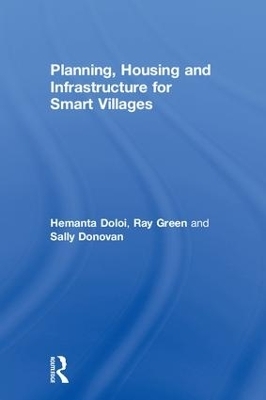
Planning, Housing and Infrastructure for Smart Villages
Routledge (Verlag)
978-0-8153-6564-8 (ISBN)
This book provides an overview of current thinking and practices that have emerged over the last thirty years for uplifting rural communities in developing economies. Drawing on a body of knowledge across a spectrum of relevant disciplines, this book provides a range of innovative ideas for rural planning, housing and infrastructure development.
Governments in many emerging economies, where rural poverty is often most acute, have attempted to improve livelihoods. Approaches and techniques that have been used for urban development are often not applicable to rural communities. Studies show that money allocated for rural development is often not effectively spent due to distance, lack of infrastructure, lack of education, poverty and other factors. Meanwhile, the gap in development between the city and country continues to grow, sometimes leading to social and political instability, in both developing and developed countries. This book seeks to provide a guidebook for meeting such challenges.
Through in-depth enquiry of global practices and thinking about rural development, and selected case studies, the authors argue that careful consideration must be given to incorporating issues of resilience, resourcefulness and the involvement of communities at grassroots levels in realising the transformation of rural settlements into Smart Villages.
Hemanta Doloi is a senior lecturer in the Faculty of Architecture, Building and Planning at the University of Melbourne, Australia. Dr Doloi is the founding director of the Smart Villages Lab (SVL) and the lead investigator of the Smart Villages Project, sponsored by the Government of Assam, India, for developing solutions on affordable housing and infrastructure systems. Ray Green is a professor in the Faculty of Architecture, Building and Planning at the University of Melbourne, Australia. He is the author of Coastal Towns in Transition (2010) and co-author of The Green City: Sustainable Homes, Sustainable Suburbs (2005). His research has been published in urban planning, landscape architecture and environmental psychology journals. Sally Donovan is a research fellow with the Smart Villages Lab in the Faculty of Architecture, Building and Planning at the University of Melbourne, Australia. Dr Donovan has over ten years’ experience researching environmental management and environmental policy development.
Chapter 1. Introduction
Rural Settlements
What is a Smart Village?
Millennium Development Goals
Making a Smart Village
Chapter 2. Income Generation
Introduction
Businesses around Agriculture
Non-Timber Forest Products
Ecotourism
Financing opportunities
Recommendations for best practise
Chapter 3. Education and Skills Development
Introduction
Providing a classroom experience
Maintaining attendance
Achieving educational attainment
ICT and libraries
Adult Education
Reducing conflict through education
Recommendations for best practise
Chapter 4. Agriculture
Introduction
Crop Management
Livestock management
Recommendations for best practise
Chapter 5. Housing
Introduction
Rural house and climatic responsiveness
Building Designs
Changes over time
Smart Villages
Recommendations for best practise
Chapter 6. Energy
Introduction
Electricity
Microgrid technology options
Hybrid systems
Electrical Energy Storage
Recommendations for best practise
Chapter 7. Waste
Introduction
Composting
Anaerobic Digestion
Recommendations for Best Practice
Chapter 8. Water and Sanitation
Introduction
Provision of potable water
Sanitation facilities
Treatment of wastewater
Balancing water resources
Recommendations for best practise
Chapter 9. Transportation
Introduction
Road infrastructure development
Road maintenance
Beyond roads: completing the picture of transport infrastructure
Recommendations for best practise
Chapter 10. Health and Wellbeing
Introduction
Foodborne illness
Prevention and treatment of communicable diseases
Access to health care
Emergency response
Recommendations for best practise
Chapter 11. Environment
Introduction
What is Biodiversity and why does it matter?
Can biodiversity loss be reversed?
Forest preservation
Permaculture
Environmentally Friendly Energy?
Recommendations for best practise
Chapter 12. Governance
Introduction
Giving citizens a meaningful voice
Government community partnerships/ local leadership
Communication between governments and citizens
Intergovernmental Communication
The role of NGOs
| Erscheinungsdatum | 18.12.2018 |
|---|---|
| Zusatzinfo | 8 Tables, black and white |
| Verlagsort | New York |
| Sprache | englisch |
| Maße | 156 x 234 mm |
| Gewicht | 453 g |
| Themenwelt | Naturwissenschaften ► Geowissenschaften ► Geografie / Kartografie |
| Sozialwissenschaften ► Soziologie ► Spezielle Soziologien | |
| Wirtschaft ► Betriebswirtschaft / Management ► Rechnungswesen / Bilanzen | |
| Betriebswirtschaft / Management ► Spezielle Betriebswirtschaftslehre ► Immobilienwirtschaft | |
| ISBN-10 | 0-8153-6564-0 / 0815365640 |
| ISBN-13 | 978-0-8153-6564-8 / 9780815365648 |
| Zustand | Neuware |
| Haben Sie eine Frage zum Produkt? |
aus dem Bereich


